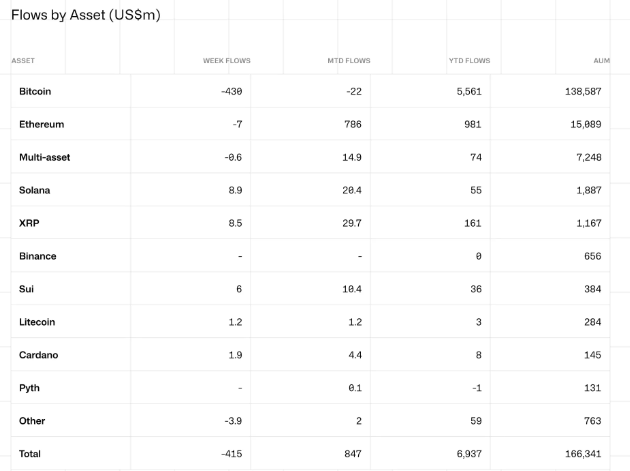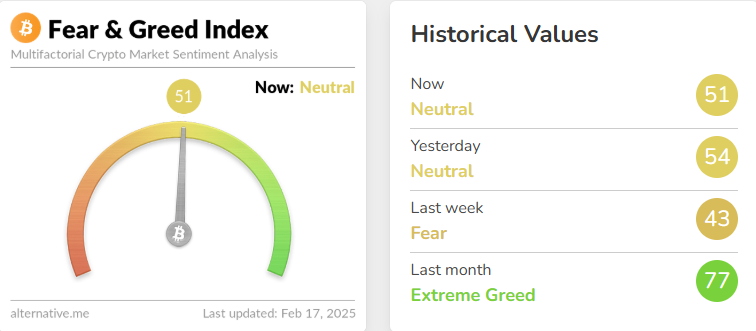-
The recent shift in the cryptocurrency market has been marked by significant outflows totaling $415 million, driven largely by hawkish comments from Federal Reserve officials and rising inflation rates.
-
This trend highlights a complex interplay between macroeconomic factors and investor sentiment, particularly as U.S.-based investors react to market signals.
-
Analyst Mike McGlone remarked, “A bit of reverse wealth effect may be the top factor to alleviate inflation, which means highly speculative crypto’s at the forefront.”
The cryptocurrency market faced a $415 million outflow as macroeconomic conditions shift; investor sentiment remains fragile amid Fed policy signals.
Bitcoin Leads the Downtrend as Crypto Outflows Surge
The latest data from CoinShares reveals that crypto markets experienced unprecedented outflows totaling $415 million last week. Bitcoin (BTC), often regarded as a bellwether for the crypto sector, was significantly affected, highlighting a growing risk-off sentiment among investors.

Crypto Outflows Reach $415 Million Last Week. Source: CoinShares
This downturn occurred amidst alarming economic signals, with the Federal Reserve indicating a YoY inflation rate of 3% in January, exceeding expectations. Core inflation figures, coming in at 3.3%, further inflated market concerns and significantly impacted investor sentiment.
The response from crypto investors has been swift; following the inflation report, the overall market cap declined by 5%, with Bitcoin briefly dipping below $95,000. Commentary from Fed Chair Jerome Powell regarding his intention to maintain high interest rates has compounded investor anxiety.
During a recent congressional testimony, Powell emphasized the importance of holding interest rates steady to combat rising inflation, a stance that has unsettled many who were anticipating a shift towards rate cuts.
“A bit of reverse wealth effect may be the top factor to alleviate inflation, which means highly speculative crypto’s at the forefront… It may be silly to expect inflation to drop until risk assets do,” noted analyst Mike McGlone.
With the market already grappling with the implications of tariffs imposed by the U.S. on key trading partners, Powell’s remarks have led to increased caution among investors. The Bitcoin Fear and Greed Index dropped into ‘Fear’ territory, signaling a cautious outlook among market participants.

Bitcoin Fear and Greed Index. Source: Alternative
According to CoinShares researcher James Butterfill, it is notable that a significant proportion of the outflows—amounting to $464 million—were from U.S.-based investors. Butterfill states, “We believe these outflows were triggered by the Congressional meeting with Fed Chair Jerome Powell, who signaled a more hawkish monetary policy stance, coupled with US inflation data exceeding expectations…The majority of outflows originated in the US…most other countries remained largely unaffected by the news.”
The First Crypto Outflows of 2025 Mark a Significant Trend Shift
The reported $415 million net outflow signifies a pivotal moment for the crypto market, marking the first net withdrawal in 2025. This followed a week where inflows had soared to $1.3 billion, representing a dramatic reversal in sentiment.
Before this downturn, the crypto landscape was characterized by strong inflows indicative of robust investor confidence, with an impressive $585 million inflow in the first week of January and a peak of $2.2 billion by the end of that month. Such fluctuations exemplify the market’s sensitivity to economic data and policy developments.
Bitcoin ETF outflows, in particular, showcased the shift; data showed outflows increasing from $56.76 million to as much as $243 million, illustrating how rate and inflation fears can directly influence investor decisions. In contrast, Ethereum ETFs exhibited more resilience, suggesting that investors may be reassessing allocation strategies in light of the prevailing economic climate.
This aligns with recent findings from a JPMorgan survey, which reported that 51% of traders view tariffs and inflation as significant factors influencing the market in 2025.

Inflation and Tariffs to Influence Markets in 2025. Source: JPMorgan Chase Survey Findings
Additionally, the survey underscored that 41% of respondents are increasingly concerned about market volatility, especially in light of unpredictable political events.
As the market awaits the imminent release of the FOMC meeting minutes, its potential impact on future inflows and outflows cannot be overstated. The focus remains sharp as investors navigate a rapidly changing economic landscape.
Conclusion
The current trend of $415 million in crypto outflows illustrates the profound impact of macroeconomic factors on investor sentiment. As inflation worries persist and the Federal Reserve maintains a stringent stance on interest rates, the crypto market’s reaction underscores the necessity for vigilance among investors. Observing future economic indicators and policy directions will be crucial as the landscape continues to evolve.






